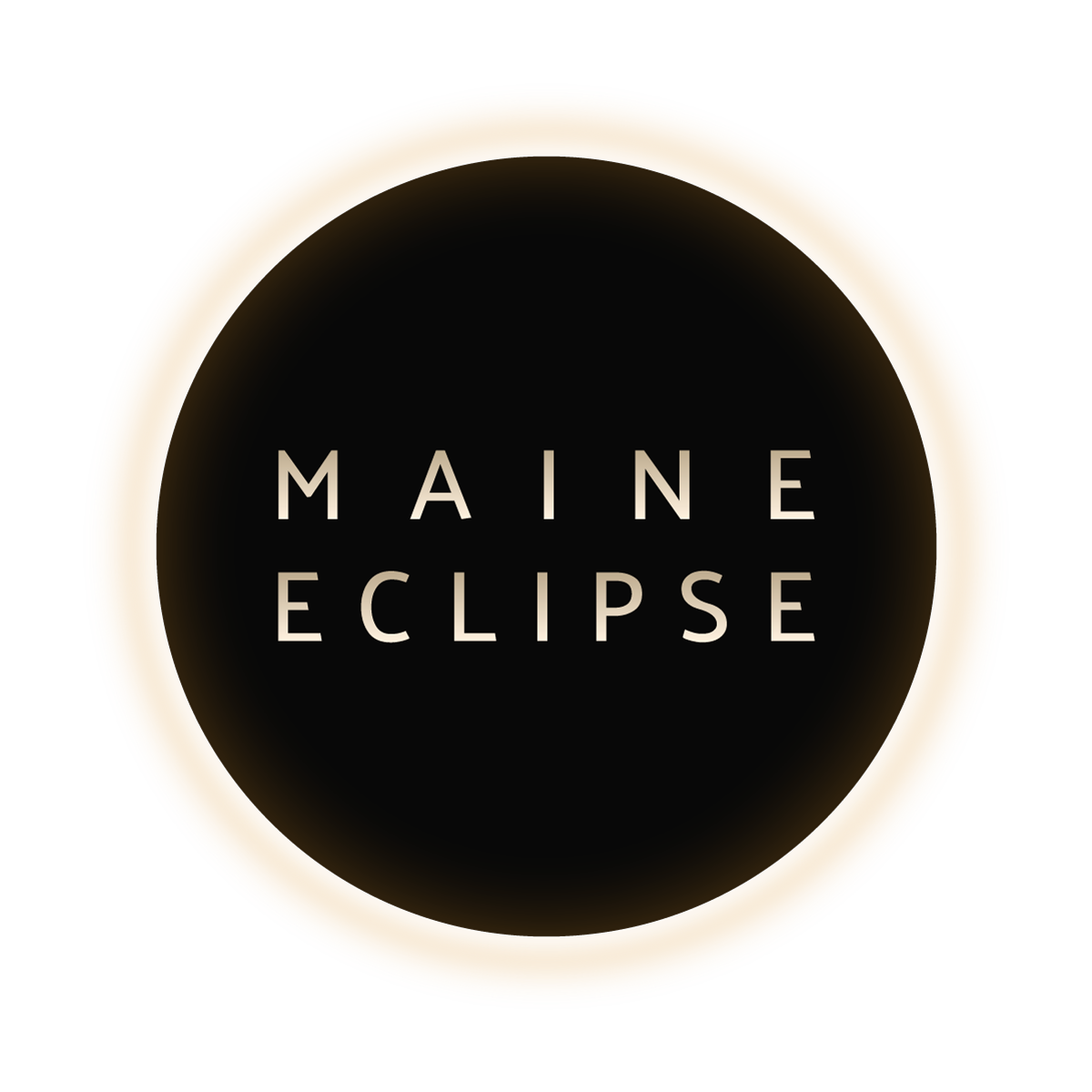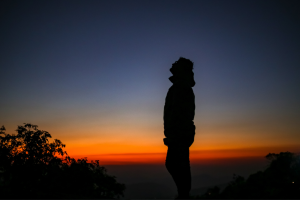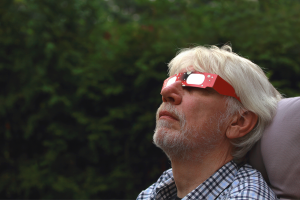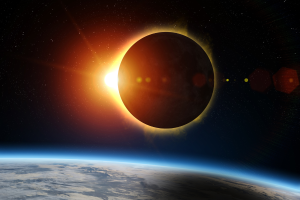(Note: “filters” is mentioned throughout this discussion and refers to the special filter material that is made specifically for viewing the sun. This filter material is made by several companies, and can be found in many different forms – from eclipse glasses to sheets that can be cut and made into customized filters for cameras, telescopes, and binoculars, and solid glass filters for use with large telescopes. Do NOT try to improvise your own material – ONLY use filter material that is ISO Certified, and has been specifically manufactured and sold as safe for direct solar viewing!)
Leading up to totality
Hopefully, you will have situated yourself in an open area with lots of friendly people, having a good time and waiting to see one of the most amazing spectacles in nature. Your location must be inside the path of totality in order for you to get the whole show. The closer to the centerline you are, the more totality you will get. Make sure you have a clear view of not only where the Sun is now, but where it’s going to be in a few hours.
You will want to have several things with you: A light-colored head covering and sunblock (you’ll be out in the Sun for at least 2-3 hours), chairs and blankets, tables for any equipment you’ve brought (though all you really need are your eyes – and your eclipse glasses!), sunglasses, a proper set of ISO-Certified solar filters or viewing glasses (you must use these for ALL phases of the eclipse except for totality itself), and lots of water to drink.
Even if you plan to take no pictures, you can bring binoculars, but do not use them without proper filters except during totality itself! You probably won’t have these filters, because you generally have to make them yourself out of the right kind of filter material. The view of totality through binoculars is outstanding, and during totality it is perfectly safe (only during totality, we said! If you don’t know when that is, then DO NOT look at the Sun through binoculars – EVER).
First Contact
At the time known as C1 (first contact), the Moon’s disk will first touch the edge of the Sun. Now, the Sun is a very bright thing, and you cannot look at it without the right eye protection in front of your eyes, so don’t try. Assuming you have the right filters in front of your eyes, and always keeping them there when you’re looking at the uneclipsed or partially-eclipsed Sun, you should try and find that very first little nibble the Moon makes as it’s first touching the Sun’s disk. At this earliest stage of the eclipse, it’s easy to see the “bite” in the Sun grow slowly larger.
Over the next hour and a half, this bite will grow, and will turn the Sun into more and more of a crescent shape. Note that there is absolutely nothing at all to see if you don’t have the proper filters to look through. Even if you could look straight at the Sun, it’s far too bright for you to be able to see any of the bite, so please make sure you have proper filters to view the eclipse.
If you're not in the path
Depending on where you are, the Moon will slowly encroach across the face of the Sun. If by some terrible twist of fate you are not in the path (what in the heck are you doing there?), then you will be able to tell that the Moon is travelling in a line taking it above or below the center of the Sun (as viewed along the Moon’s line of travel). That means that there will come a time when the Moon has covered as much of the Sun as it’s going to, and it will then move off toward the opposite edge of the Sun, leaving an ever-narrowing bite – until the bite is no more. That’s called Fourth Contact, and it means that for you, the eclipse is over.
Now, if you’re just outside the path, like maybe less than 30 miles or so, then you will experience “deep” partiality. The Moon will still track off-center, but at the time of maximum coverage, lots of the Sun will end up being covered by it. Now, it’s still not safe to look at without filters (!), but the deeper the partiality you get, the more of the “edge” effects you’ll get to see. By that, we mean that you’ll see (through your eclipse glasses, of course) a very thin sliver of the sun – the closer you are to the path, the thinner the sliver you’ll see. You’ll also get to see the sky darken a bit, and if you’re really close to the path, the overall eerieness of the quality of the light around you will deepen, and you’ll get that weird feeling that the light isn’t right, and that something very strange is going on around you. But, that’s it. That’s all you’ll get, and like your friends who are still well outside the path, you’ll also come away feeling like you didn’t quite get the full experience.
The partial phase deepens
Let’s say, then, that you’ve happily found your way into the path. EVERYTHING THAT FOLLOWS ASSUMES YOU ARE IN THE PATH OF TOTALITY. You don’t have to be right on the centerline, but the closer to the centerline you are, the more totality you’ll get. So, let’s consider if you’re in the middle half of the path, nearer the centerline than you are to either edge. What happens then?
Well, you’ll still see all the effects of deepening partiality. You’ll get the shrinking sliver of Sun, which is kind of cool but is not the real show. As the sliver thins, though, you get the very weird atmosphere that surrounds an eclipse, which is very difficult to describe. As the sliver of sun gets thinner and thinner, the sky darkens a bit, and the light around you takes on a weird, “clearer” quality. Everything seems sharper and clearer, though darker. It’s kind of like if you were squinting, and everything seemed much more distinct to you. It’s very strange, and it’s a very powerful effect on your senses.
As partiality deepens, and the sliver of Sun shrinks even more, the sky gets darker – very slowly, but noticeably darker. You don’t really see it happening, but you can tell it’s changing somehow. The shadows on the ground become very sharp, very contrasty, and you feel like there’s something wrong with your eyes.
The wind picks up a bit, and the temperature drops noticeably. Birds roost, evening insects come out, and the world prepares for sunset in the middle of the day….
Onset of Totality
Partiality deepens even more, and the atmosphere actually starts to be a little scary. The sky gets a deeper and deeper dark blue, a kind of gray veil falls over everything, and the Sun-sliver gets thin enough that you can actually (through your filters, remember?) start to see it shrinking as you watch it. In the five minutes before totality, you can really get a feel for how earth-shatteringly frightening this event must have been to ancient people who had no idea what was going on. We can truly believe that people could have been frightened to death! But not us – the spectacle gets your heart beating fast, your mouth watering for more, and your whole body trembling with excitement that you’re being swept along in a wonderful dance of the cosmos that nothing is going to stop.
As the last bite of the Sun slides away, things happen way too fast to describe concisely. You simply cannot focus on every one of the events that are taking place all around you, so you have to pick the few that seem the coolest to you. (There will be more eclipses, after all, and in about 5 minutes you’re going to be on the phone making travel plans to see the next one!) The most important thing going on is the actual Sun up in the sky, but let’s take a peek at just a couple of other things first.
The sky surrounding the Sun will grow very dark very quickly. In real time, you will be able to see the deep blue turn to twilight blue, and then to bluish-black. Stars and planets will pop out of nowhere. Roosters will crow and insects will chirp as though night is falling. The temperature has dropped maybe 10 degrees, and there is a positively electric energy that everyone around you is sharing. It is a very positive and uplifting experience, which everyone should have the opportunity to enjoy at least once!
If you look to the west, you’ll see a beautiful black curtain rising up out of the Earth, with hints of sunset-orange north and south of it, while off to the east, the sky at the horizon is still rather light. On the ground, your shadow will become impossibly clear and thin, and then will vanish completely as the Sun’s light fades to about the intensity of the full Moon. In the last few seconds before totality, that dull blackness you saw off to the west will suddenly spring up out of the Earth, and take over the whole sky like a gigantic curtain being pulled over you. If you aren’t focused on the Sun at that time, you’ll be looking at the actual shadow of the Moon racing toward you at supersonic speed, covering you with its blackness. If you see that, you’re very lucky, because it happens so fast. And besides, you’ll probably be too awe-struck by what’s going on center stage…
As the last sliver of Sun melts away, you will be able to see several things happening simultaneously. You will now definitely have the feeling that there are two bodies involved, because it is impossible to miss the movement of the Moon’s disk in these last seconds. (You should still be watching through the eclipse glasses, by the way.) But while the last bit of the sliver is shrinking, the Sun’s corona will start to come out. The last little bit of the Sun’s light will glare through valleys on the Moon, and will create a “bead” effect at the edge of the Moon’s disk. These are called “Baily’s Beads”, and they are stunning. These will dance around a little, and then will fade away as the very last one of them brightens into a huge bead. Around the edge of the Moon, the Sun’s corona will begin to glow, giving us the famous “diamond ring” effect. It lasts for only about 2-3 seconds, but it is stunning beyond words. Most people will take their filters off at this point (though technically, you’re not supposed to look until the diamond ring is totally gone, we’re just saying that some people choose to do it anyway). You will see the corona burst into view as the diamond fades away, appearing as though someone is smearing wispy-white cotton candy all around the impossibly black hole that’s been cut out of the fabric of a blue-black sky. There may be tongues of red fire visible around the edge of the Sun – these are solar prominences, and no one knows what they will look like until they see them right along with you. The corona’s shape is like that, too. There may be predictions of what it will look like, but every eclipse is different.
Once you can’t see anything at all with your filters, take them off! You will see nothing if you keep them on, and now, during totality, they’re not necessary! Keep them in your hand for when totality is over, but use your eyes. Use your binoculars with impunity. Don’t look away if you can help it. The diamond is gone, all the sun’s light is blocked, and you’re looking at the most beautiful thing you’re likely to ever see – the solar corona, shimmering around the Moon’s disk brilliantly (and which is only about as bright as the full Moon). It will look to you as though someone has painted the sky a deep bluish-purplish-black, has cut an impossibly black, perfectly circular hole in it with a pair of scissors, and then smeared radiant, glowing, shimmering cotton candy around that hole. No picture in the world can do justice to the sight you have before you, and you will want to etch it in your memory forever. Ten years from now, you’ll still be able to imagine this sight in your mind.
If you have a second to look away, look at the horizon all around you. It will be the orange of a sunset, all the way around the whole horizon! You are in the middle of the circle of shadow that the Moon has projected onto the surface of the Earth, and all around you at the horizon, the eclipse is not total! You’re seeing the sunset effects of the Sun’s light from a hundred miles away. It will be too dark for you to see anything close at hand, but remember NO flashlights, NO flash pictures. Experience everything that is going on around you, as you share this moment with all the people who are now your eclipse buddies forever.
After the initial cheers from the crowd, the atmosphere will settle a little, and you’ll be tempted to look away. This is the stage where you have to remember that you’re only going to get this show for a VERY short time, and you have to record it in your mind in order to keep it forever. NO pictures will ever do it justice, so whatever you store in your brain is what you’re going to be left with. Enjoy it, and immerse yourself in it. Tomorrow, you will look at the pictures in the paper, and you won’t believe that those are pictures of what you remember seeing!
You’ll know when totality is finally coming to an end, because the western sky will brighten dramatically. The shadow is racing along to the next group of eagerly-awaiting victims to the east, and your time is sadly coming to an end. The right side of the Sun’s black disk will brighten a little, you may see prominences or chromosphere again, and some people will plaintively yell “no, please don’t go away”. Just like that, the corona will dim, the diamond ring will flash into view on the right side of the Sun’s disk (and it’s time again for your eclipse glasses to go back on!), the whistle will blow, the beads will come back, and it will be over. That bright bead of sunlight tells you that the Sun has come back, and you need to IMMEDIATELY put on your eclipse glasses or filters. The shadows will come back, the sky will brighten, and the sliver of Sun will majestically return. This is third contact – the end of totality.





